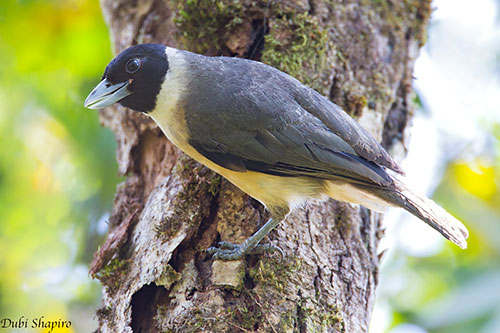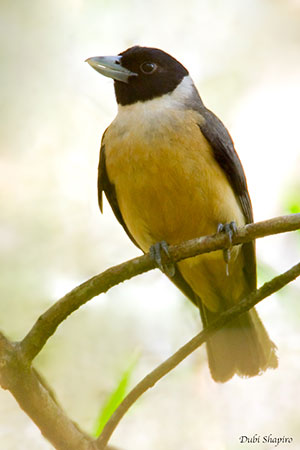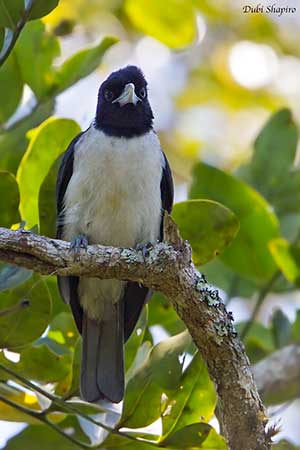
REPRODUCTION OF THIS SPECIES:
The laying occurs by mid-September, and the nesting period from October through December.
The nest is a cup-shaped structure made with leaves and grass blades. The outside walls are made of plant fibres, coarser on the lower half. The nest is anchored to a branch by fibres. It is placed in tree fork, about 4-5 metres above the ground.
The female lays 2 eggs and both adults incubate, brood and feed the young. At hatching, the chicks have closed eyes, yellow gape and pink skin. They are fed with insects, caterpillars and other unidentified food items.
The observed pair appeared not to have helpers.
PROTECTION / THREATS / STATUS:
The Pollen’s Vanga has restricted range in E Madagascar, and it depends on the forest. It is threatened by habitat loss through slash-and-burn cultivation and commercial logging.
The population is decreasing, owing to degradation and deforestation of the habitat. The species is locally common to scarce, and patchily distributed.
The Pollen’s Vanga is currently listed as Near Threatened.
Fr: Vanga de Pollen
Ang: Pollen’s Vanga
All: Pollenvanga
Esp: Vanga de Pollen
Ita: Vanga di Pollen
Nd: Pollens Vanga
Sd: svartbröstad vanga
Mal: fotsimaso, Tsilovanga, Vanga, Vangamaintiloha
Photographer:
Dubi Shapiro
Dubi Shapiro Photo Galleries & Dubi Shapiro's Pictures on IBC
Text by Nicole Bouglouan
Sources:
HANDBOOK OF THE BIRDS OF THE WORLD Vol 14 by Josep del Hoyo-Andrew Elliot-David Christie - Lynx Edicions – ISBN: 9788496553507
Wildlife of Madagascar par Ken Behrens, Keith Barnes - ISBN: 140088067X, 9781400880676 – Editeur: Princeton University Press, 2016
Birds of Madagascar: A Photographic Guide Par Pete Morris, Frank Hawkins – ISBN: 0300077556, 9780300077551- Editeur: Yale University Press, 1998
Birds of the Indian Ocean Islands Par Ian Sinclair, Olivier Langrand - ISBN: 1868729567, 9781868729562- Editeur: Struik, 2003
The Birds of Africa: Volume VIII: The Malagasy Region: Madagascar, Seychelles, Comoros, Mascarenes - Par Roger Safford, Frank Hawkins – ISBN: 1408190494, 9781408190494- Editeur: A&C Black, 2013
Birds of Madagascar and the Indian Ocean Islands Par Roger Safford, Adrian Skerrett, Frank Hawkins – ISBN: 1472924118, 9781472924117- Editeur: Bloomsbury Publishing, 2015
Madagascar Wildlife: A Visitor's Guide Par Nick Garbutt, Hilary Bradt, Derek Schuurman – ISBN: 1841622451, 9781841622453 - Editeur: Bradt Travel Guides, 2008
Aspects of the Breeding Biology of Pollen's Vanga (Xenopirostris pollen) in Southeastern Madagascar
Creagus – Bird Families of the World – Vangas - Vanginae
THE VANGAS OF MADAGASCAR by Nick Garbutt
Vanga - From Wikipedia, the free encyclopedia
Home page
Page Order Passeriformes
Pollen’s Vanga
Xenopirostris polleni
Passeriformes Order – Vangidae Family
INTRODUCTION:
The Pollen’s Vanga is endemic to Madagascar where it occurs in restricted forest habitat in the east of the island. It feeds on invertebrates and small vertebrates found in dead wood and under dead bark, and caught by probing and gleaning.
The species is threatened by habitat loss, and the remaining forest will probably disappear within decades. The Pollen’s Vanga is listed as Near Threatened.
The name of this species pays tribute to François Paul Louis Pollen (1842-1886), a Dutch naturalist and merchant who made major contributions to the study of the Malagasy fauna.
DESCRIPTION OF THE BIRD:
Biometrics:
Length: 24 cm
Weight: 62-65 gr
The Pollen’s Vanga adult male has slaty-grey upperparts including upperwing and tail. The primaries, primary coverts and alula are blackish.
The underparts are whitish, sometimes with pale orange wash.
Head, chin and throat are black, and the latter extends to upper breast. Neck sides are white.
The bill is bluish-white but bluer at base. It is laterally flattened and well-adapted to the feeding behaviour of this species. The eyes are blackish. Legs and feet are dark grey.

BEHAVIOUR IN THE WILD:
The Pollen’s Vanga feeds on invertebrates such as insects including Coleoptera and Blattodea species and others, larvae and worms. It also takes small vertebrates, usually chameleons.
It uses its laterally flattened bill to peel bark from dead wood, and excavates grubs and invertebrates. It searches in nooks in dead wood, under dead bark and in twigs. It feeds by probing and gleaning.
The Pollen’s Vanga can be found alone, in pairs or in small family groups of 3-4 individuals. However, it often joins mixed-species flocks, mainly with other large vangas.
The breeding biology of this species is poorly known. Both adults take part in nesting duties, from nest-building and incubation to chick rearing.
From an observation, some behaviour was observed between the mates, especially during nest exchange, preceded by vocalizations by the arriving adult. The brooding bird flew away almost immediately. The returning bird gave a soft whistle described as “whit” or “whoot” and some variations. This call is given in series of up to 8 notes.
The male defends the nest and gives louder rendition of the “whit” call while chasing an intruder.
The Pollen’s Vanga is probably monogamous. Both mates share the nesting duties without help from other birds (helpers).
The species is probably sedentary on the island. It flies only from dead tree to another while foraging.

The adult female resembles male, but the black hood lacks the extension on to the upper breast. The breast is tinged orange, sometimes strongly. A white collar separates the head from the body. The upperparts are strongly tinged olive.
The juvenile resembles adult. The very young birds are paler than the female. The bill is pink with orange gape. The one-year-old male has blotchy orange breast with scattered black spots.
RANGE:
The Pollen’s Vanga is found in E Madagascar where it is patchily distributed.
HABITAT:
The Pollen’s Vanga frequents the primary evergreen humid forest, from sea-level to 2,000 metres of elevation.
CALLS AND SONGS: SOUNDS BY XENO-CANTO
The Pollen’s Vanga gives a loud whistled call “tsseee ooo” or “tsseee ang”, a very penetrating, high-pitched whistle lasting for about two seconds and repeated at short intervals. It also produces a loud “whip”. The contact call is “whip-whip-whip”. When alarmed, it utters a quiet “chuck-chuck-chuck” and various whistles.
Two birds may occasionally counter-sing.
